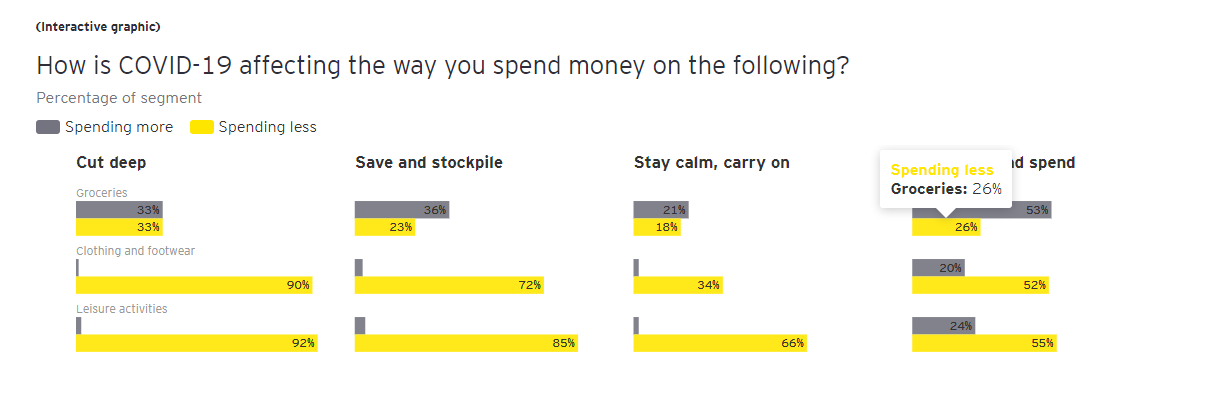The COVID-19 pandemic is expected to negatively impact retail holiday shopping plans this year. According to the latest survey findings, more than half of consumers (54%) expect to participate in sales events and 42% plan to spend less than a year ago. 91% of those who will participate will shop for deals online exclusively rather than doing it in a physical brick and mortar store. However, these online holiday shopping plans differ significantly across markets, categories and products that the users shop for.
The COVID-19 pandemic has accelerated the transition to online shopping and its long-term adoption in certain product categories and markets, according to the fifth edition of the EY Future Consumer Index. More than a third (37%) of the 14,467 consumers surveyed say the pandemic will keep impacting their lives for at least another year. This rises to 43% in Europe and 66% in Japan, while consumers in India (19%) and China (18%) are noticeably more optimistic. Globally, consumer respondents believe the way they shop will change over the long-term and 39% say they will shop more online for things they used to buy in stores.
Marketing Technology News: MagicLamp Software Announces Armand Lange as Vice President of Sales
China is the Biggest Online Shopping Destination
The EY Future Consumer Index finds that consumers in China and, to a lesser extent, the UK are far more likely to shop online as their primary channel than those elsewhere. Those in Germany and France are less open to the idea.
Overall, respondents identified appliances and technology (53%) as a category of products they will primarily buy online, while beverages and fresh food are categories they will prefer to purchase in-store.
Online grocery shopping penetration continues to be lower in most markets.
The good thing is that the online shopping marketplace has improved since April 2020, when EY stated that consumers are making some “deep cuts” in their spending. The age group between 18-44 years, who were most paranoid about the COVID19 effects on their lifestyle and health, were tagged as “Hibernate and spend” categories. This segment reported that 40 percent times they would shop less frequently online, and 46 percent of them were focusing only on brands.

But during the pandemic, 55% of consumers have bought their groceries online at least once. Of those, 42% say they are now ordering groceries online more frequently because of the COVID-19 pandemic. Looking to the future, 19% of respondents say they will primarily shop online for fresh food and 16% for non-alcoholic beverages, up from 3.4% and 1.6% respectively in 2019. This trend shows that online shopping, even in low penetration categories, is not only on the rise, but is a trend that will most likely stick post-pandemic.
The survey also notes that the categories in which consumers are most likely to buy online are also the categories in which they are most likely to value service and advice when making a purchase – technology, beauty and cosmetics, and clothing, shoes and accessories.
Andrew Cosgrove, EY Global Consumer Knowledge Leader, says:
“This points to the risk of showrooming, with consumers going to stores to touch and feel the product for the experience but then making purchases online where products might be cheaper. Retailers and consumer product companies will need to ensure they have both seamless omnichannel experience and the stock and price point needed to make the sale.”
Marketing Technology News: Now, One WhatsApp Business Account for Omnichannel Messaging and Experience Management
Impact of the COVID-19 pandemic on big sales events
As a result of the COVID-19 pandemic, 40% of respondents have seen their incomes decrease and a majority (60%) are now thinking more carefully about how they spend their money. Furthermore, 41% of consumers have cut spending on non-essentials and 46% are postponing the purchase or replacement of big-ticket items. These trends point to a potentially slower end-of-year shopping season.
Although more than half (54%) of consumers expect to participate in the next big shopping or sales event, EY Future Consumer Index data suggests that 42% of consumers globally plan to spend less during the shopping season than a year ago.
Of those who will participate, 91% will spend at least half of their shopping spend online, showing the importance of online retail this season.
Kristina Rogers, EY Global Consumer Leader, says:
“With such a rapid shift to online shopping, business leaders must challenge their assumptions about what the digital consumer wants. Multi-billion-dollar opportunities are emerging from the pandemic and now is the time to develop a distinctive online strategy and prioritize the critical moments of truth along the end-to-end shopper journey.”
Marketing Technology News: ConsumerTrack Celebrates Growth with New Expansion in Hawaii











